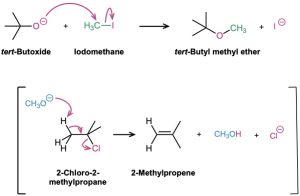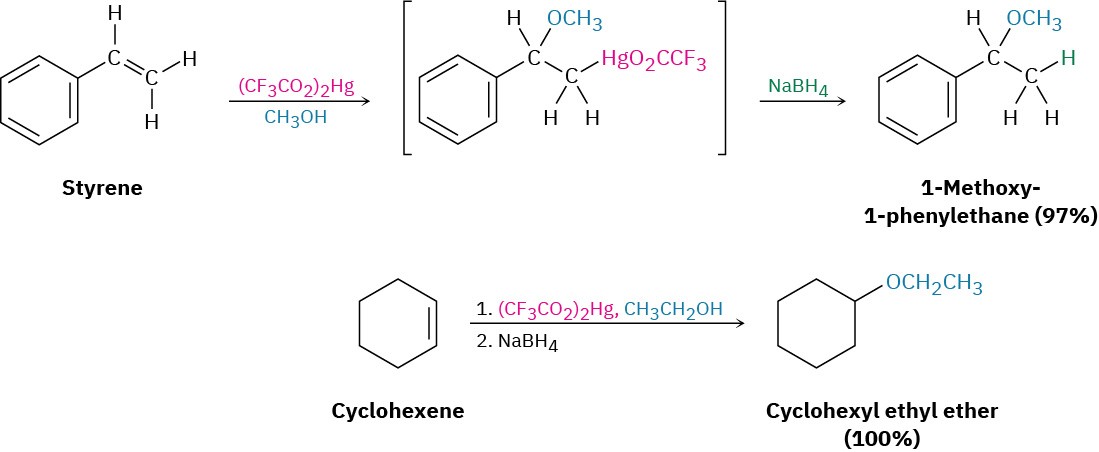Diethyl ether and other simple symmetrical ethers are prepared industrially by the sulfuric-acid-catalyzed reaction of alcohols. The reaction occurs by SN2 displacement of water from a protonated ethanol molecule by the oxygen atom of a second ethanol.
Unfortunately, this method is limited to use with primary alcohols because secondary and tertiary alcohols dehydrate by an E1 mechanism to yield alkenes (Section 17.6).

The Williamson Ether Synthesis
The most generally useful method of preparing ethers is the Williamson ether synthesis, in which an alkoxide ion reacts with a primary alkyl halide or tosylate in an SN2 reaction. As we saw in Section 17.2, the alkoxide ion is normally prepared by reaction of an alcohol with a strong base such as sodium hydride, NaH.

A useful variation of the Williamson synthesis involves silver oxide, Ag2O, as a mild base rather than NaH. Under these conditions, the free alcohol reacts directly with the alkyl halide, so there is no need to preform the metal alkoxide intermediate. Sugars react particularly well; glucose, for example, reacts with excess iodomethane in the presence of Ag2O to generate a pentaether in 85% yield.

Because the Williamson synthesis is an SN2 reaction, it is subject to all the usual constraints, as discussed in Section 11.3. Primary halides and tosylates work best because competitive E2 elimination can occur with more hindered substrates. Unsymmetrical ethers should therefore be synthesized by reaction between the more hindered alkoxide partner and less hindered halide partner rather than vice versa. For example, tert-butyl methyl ether, a substance used in the 1990s as an octane booster in gasoline, is best prepared by reaction of tert-butoxide ion with iodomethane rather than by reaction of methoxide ion with 2-chloro-2-methylpropane.

Problem 18-2
Why do you suppose only symmetrical ethers are prepared by the sulfuric-acid-catalyzed dehydration procedure? What product(s) would you expect if ethanol and 1-propanol were allowed to react together? In what ratio would the products be formed if the two alcohols were of equal reactivity?
Problem 18-3
How would you prepare the following ethers using a Williamson synthesis?
(a) Methyl propyl ether
(b) Anisole (methyl phenyl ether)
(c) Benzyl isopropyl ether
(d) Ethyl 2,2-dimethylpropyl ether
Alkoxymercuration of Alkenes
We saw in Section 8.4 that alkenes react with water in the presence of mercuric acetate to yield a hydroxymercuration product. Subsequent treatment with NaBH4 breaks the C–Hg bond and yields the alcohol. A similar alkoxymercuration reaction occurs when an alkene is treated with an alcohol in the presence of mercuric acetate or, even better, mercuric trifluoroacetate, (CF3CO2)2Hg. Demercuration by reaction with NaBH4 then yields an ether. The net result is Markovnikov addition of the alcohol to the alkene.

The mechanism of the alkoxymercuration reaction is similar to that described in Section 8.4 for hydroxymercuration. The reaction is initiated by electrophilic addition of Hg2+ to the alkene, followed by reaction of the intermediate cation with alcohol and reduction of the C– Hg bond by NaBH4. A variety of alcohols and alkenes can be used in alkoxymercuration. Primary, secondary, and even tertiary alcohols react well, but ditertiary ethers can’t be prepared because of steric hindrance.
Worked Example 18.1 Synthesizing an Ether
How would you prepare ethyl phenyl ether? Use whichever method you think is more appropriate, Williamson synthesis or the alkoxymercuration reaction.
Strategy
Draw the target ether, identify the two groups attached to oxygen, and recall the limitations of the two methods for preparing ethers. Williamson synthesis uses an SN2 reaction and requires that one of the two groups attached to oxygen be either secondary or (preferably) primary. The alkoxymercuration reaction requires that one of the two groups come from an alkene precursor. Ethyl phenyl ether could be made by either method.

Solution

Problem 18-4
Review the mechanism of oxymercuration shown in Figure 8.4, and then write the mechanism of the alkoxymercuration reaction of 1-methylcyclopentene with ethanol. Use curved arrows to show the electron flow in each step.
Problem 18-5
How would you prepare the following ethers? Use whichever method you think is more appropriate, Williamson synthesis or the alkoxymercuration reaction.
(a) Butyl cyclohexyl ether
(b) Benzyl ethyl ether (C6H5CH2OCH2CH3)
(c) sec-Butyl tert-butyl ether
(d) Tetrahydrofuran
Problem 18-6
Rank the following halides in order of their reactivity in the Williamson synthesis:
(a) Bromoethane, 2-bromopropane, bromobenzene
(b) Chloroethane, bromoethane, 1-Iodopropene

